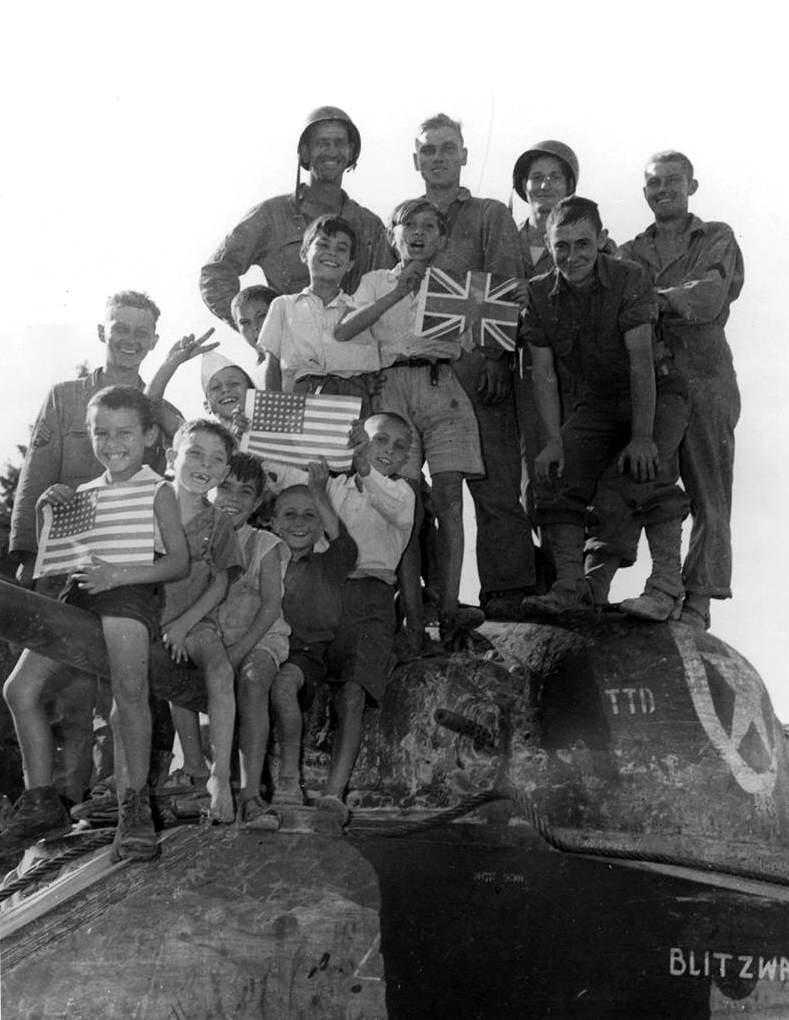
World War II Campaigns: Sicilian Campaign--Armor

Figure 1.--Italy was an Axis country. Yet the Allies, especially the Americans, were seen as liberators beginning with the invasion of Sicily (July 1943). After the first 3 days and the fight for the Sicily beachhead, the American Shermans were the primary battlefied tank. The Germans were reduced to using their small number of heavily armored tanks as mobile pill boxes. The press caption here read, "Sicilian youngster make friend with an American tank crew in northern Sicily. The American soldiers, all of whom have seen plenty of action on the island are L. to R. Sgt. John Dvoorak of Texas, Dude Adress of Texas, Sgt, Ed Bagger of Illinois, and PFC Tom McNally of New York." Notice the European names. It is almost as if a pan-European Army had begun the liberatin of Europe. Photographer: O.W.T. Staff photo by Stapleton.
|
|
The tank at the beginning of World War II was a decisive weapon on the battlefield, a major factor in the early German victories. This was not the case on Sicily. The Germans had only a small number of tanks which could not be concentrated. And the availability of anti-tank guns along with infantry anti-tank weapons changed the battlefield importanc of the tank. The American M-4 Sherman tank when introduced in 1942 was a highly effective tank. As a result of encounters with the Soviet T-34 tank on the Eastern Front, The Germans began major upgrades of their tanks. The Mark V Panther and Mark VI Tiger I appeared on the 1943 battlefied, outclassing the American Sherman in armament and armor. The Shermans had greater mobility, but the terraine of Sicily favored the heavily armored German tanks. Schwere Panzer-Abteilung 504 (sPzAbt. 504), was the second Tiger unit to be sent to Tunisia. The company reached ed in Tunisia (March 1943). The 2nd company was held in Sicily. The company had four platoons, each with two Tiger I tanks and two Pzkpw III support tanks. OKH as the situation deteriorated in Tunisia ordered that armor on Sicily remain there. Altogether 17 Tigers were on Sicily when the Allies landed. Attached to Panzer Division Hermann Göring, the 17 Tigers under the 2. Kompanie of the 504th attacked the American landing zone (July 11). Over 3 days of intense combat, the Americans managed to stop the German Panzers. We see references to Allied naval gunfire. We can not yet confirm that. The Germans did not have needed support and repair units. Thus minor damage could ecapacitate a panzer. The Allies might not penetrate German armor, but a minot hits on the treads could stop a mighty Tiger, meaning they could not advance or retreat along with the ground troops. The Germans did not have the needed specialised workshops personnel and equipment. The Germans themselves destroyed over half of their Tigers to prevent capture. The Germans after the first 3 days lost much of their armor. And the surviving Panzers could only be used as mobile pill boxes. Overall, the small number of German tanks and lack of air support meant that after the fight for the beach heasd, the Germans could only play a role in blocking or slowing down the Allied advance. The terraine was rough and mountenous, unlike the flat plains of the Eastern Front which was ideal tank country in which mobility was a key factor. Rather on Sicily armor was often restricted to roads. And as a result of the poor infrastructure, there were only a few roads which the Germans did their best to block, especially the eastern and northern coastal roads. This meant that the Shermans mobility counted for little and a small number of the heavily armored German tanks could block the roads. The vShermas were available bin considerable numbers to support the ground offensive.
CIH -- WW II

Navigate the CIH World War II Section:
[Return to Main Sicilian campaign page]
[Return to Main Italian campaign page]
[Return to World War II European campaign second phase page]
[About Us]
[Aftermath]
[Biographies]
[Campaigns]
[Children]
[Countries]
[Deciding factors]
[Diplomacy]
[Geo-political crisis]
[Economics]
[Home front]
[Intelligence]
[Military forces]
[POWs]
[Resistance]
[Race]
[Refugees]
[Technology]
[Totalitarian powers]
[Bibliographies]
[Contributions]
[FAQs]
[Images]
[Links]
[Registration]
[Tools]
[Return to Main World War II page]
[Return to Main war essay page]
[Return to CIH Home page]
Created: 11:28 PM 4/26/2019
Last up dated: 11:28 PM 4/26/2019



